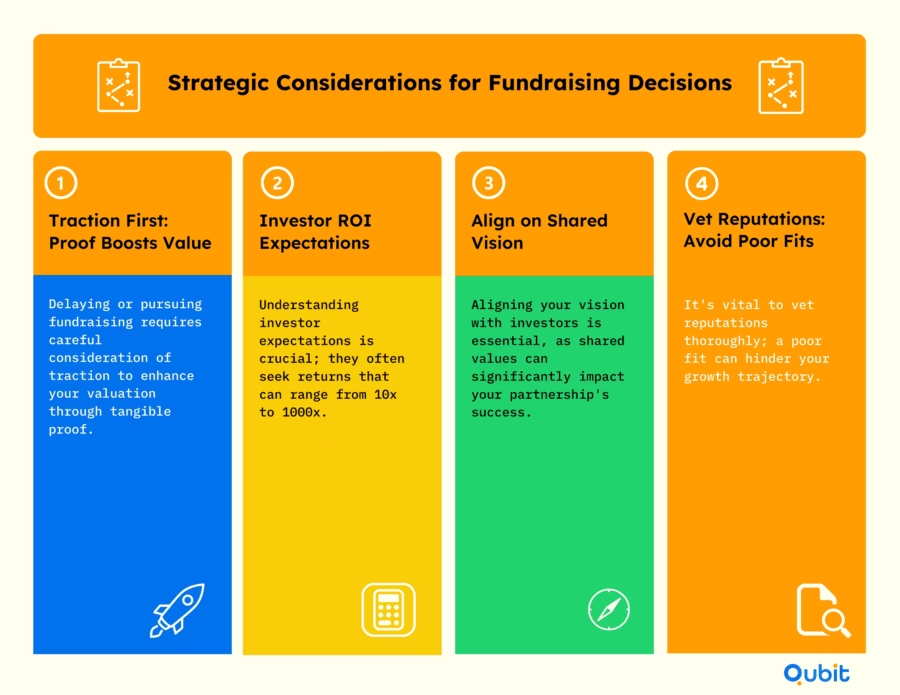When should you raise money—and when should you just keep building? For founders deciding between fundraising for startups and self-financing, the timing can define the outcome.
This post breaks down the differences between bootstrapping and external funding. You’ll learn what each model demands, what it protects, and where it can take you. It’s not just about money. It’s about control, momentum, and long-term risk.
For a broader look at capital strategies, this guide to types of startup funding maps out what’s available beyond equity and loans—including lesser-known fundraising ideas for business startup ventures.
When To Go For Fundraising?
Timing your fundraising efforts is crucial for startup success. While external capital can accelerate growth, rushing into fundraising for startups too early can lead to unfavorable terms and long-term challenges. Below are key guidelines to help founders determine the right moment to raise capital and ensure alignment with investors.

1. Delay Fundraising to Strengthen Valuation
Postponing fundraising until your startup demonstrates clear traction can significantly improve valuation. Investors often assess metrics like revenue growth, customer acquisition, and market validation before committing funds. By delaying, you position your company for better terms and reduce equity dilution.
2. Understand Investor Return Expectations
External capital often comes with high return expectations, ranging from 10-100x and, in some cases, up to 1000x. These expectations can shape investor dynamics, influencing decision-making and growth strategies. Founders must weigh the high risk-high reward nature of investment capital carefully, as it can amplify both opportunities and obligations.
3. Align with Long-Term Vision
Not all investors are a good fit for your startup’s long-term goals. Before raising funds, ensure alignment with potential investors regarding your vision, values, and growth trajectory. Misaligned partnerships can lead to conflicts that hinder progress.
4. Validate Investor Reputations Thoroughly
Conduct due diligence on investor reputations before entering agreements. Research past investments, portfolio companies, and feedback from other founders. A trustworthy investor can be a valuable partner, while a poor fit may create unnecessary hurdles.
Qubit Capital Can Help
At Qubit Capital, we specialize in guiding startups through the complex startup fundraising process. Whether you need strategic advice or connections to reputable investors, our team is here to support your journey.
When To Go For Bootstrapping?
Bootstrapping offers entrepreneurs a unique path to build their businesses while maintaining control and ownership. Unlike traditional fundraising for startups, bootstrapping relies on self-funding, allowing founders to grow organically and validate their product-market fit without external pressures. This approach is particularly suited for businesses aiming for moderate returns, typically in the $5-10M range, and provides significant advantages in terms of operational flexibility and ownership retention.
The Benefits of Bootstrapping
- Retaining Ownership and Control
Bootstrapping empowers founders to retain majority ownership of their companies. Without external investors, decision-making remains in the hands of the founders, enabling them to steer their business according to their vision. This operational flexibility can be invaluable, especially in the early stages of growth. - Improved Valuations Through Delayed Funding
Delaying external funding can lead to better valuations and more favorable deal terms. Companies that bootstrap often demonstrate organic growth and validated market fit, making them more attractive to investors when they eventually seek funding. Atlassian serves as a prime example of this strategy; the company scaled significantly before taking on major external funding, showcasing the power of self-funding in achieving growth. - Organic Validation of Product-Market Fit
Bootstrapping forces businesses to focus on their core offerings and customer needs. This organic approach to growth ensures that the product or service resonates with the target market, reducing the risk of misaligned priorities often seen in externally funded ventures.
Challenges to Consider
While bootstrapping offers numerous advantages, it comes with its own set of challenges:
- Limited Scaling Potential
Without external capital, scaling operations can be slower. Founders may need to prioritize incremental growth over rapid expansion, which can be a disadvantage in competitive industries. - Hiring Constraints
Self-funded businesses often face budgetary restrictions, making it difficult to attract top talent or expand teams quickly. This can limit the company’s ability to execute ambitious plans or diversify its skill set.
Real-World Examples
Several companies have demonstrated the effectiveness of bootstrapping strategies:
- Atlassian: By focusing on organic growth, Atlassian achieved significant milestones before seeking external funding, proving that bootstrapping can lead to scalable success.
- Bean Ninjas: This service business launched in just seven days without external capital and later scaled profitably, highlighting how speed and focus can compensate for limited resources.
If fundraising isn’t the right fit, self-funding remains a viable option. Bootstrapping strategies for startups outlines how founders can maintain ownership while scaling on their own terms.
Bootstrapping is not just a funding strategy; it’s a mindset that prioritizes sustainable growth, ownership, and adaptability. By understanding its benefits and challenges, founders can make informed decisions about whether this approach aligns with their business goals.
Smart Capital Strategies to Grow Your Startup
Securing external capital can be a transformative step for startups aiming to scale rapidly. However, the process requires a strategic approach to ensure funding aligns with long-term goals. From crafting compelling pitch decks to exploring non-dilutive financing options, mastering these strategies can position your startup for sustainable growth while minimizing equity dilution.
1. Crafting a Clear Cap Table Story
Investors often scrutinize cap tables to assess ownership distribution and potential future dilution. A well-organized cap table tells a story of transparency and strategic planning. Startups should ensure their cap tables are easy to understand, showcasing a balanced equity structure that reflects thoughtful decision-making. Tools like the Convertible Note Agreement Template can simplify early-stage financing deals, allowing startups to secure funds without prematurely setting a valuation.
2. Rational Seed-Stage Valuations
Valuation is a critical factor in fundraising for startups. Overvaluing your company can deter investors, while undervaluing it risks excessive equity dilution. Rational seed-stage valuations should be based on realistic revenue projections, market potential, and competitive analysis. Collaborating with specialized firms can provide expert legal guidance to navigate complex valuation negotiations and protect your interests.
3. Creating Pitch Decks That Resonate
A pitch deck is your startup’s first impression on potential investors. It should combine compelling storytelling with hard data to demonstrate your business’s scalability and profitability. Highlight key metrics, such as customer acquisition costs and lifetime value, while addressing market opportunities. For startups in niche sectors like biotech, emphasizing innovation and potential impact can make your pitch stand out.
4. Exploring Non-Dilutive Financing Options
Non-dilutive funding can be a game-changer for startups in sectors like biotech, where research and development costs are high. Grants, revenue-based financing, and partnerships offer alternatives to equity-based funding. For instance, revenue-based financing explained outlines flexible funding options that scale with your income rather than requiring equity. These methods allow startups to retain ownership while accessing the capital needed for growth.
5. Mastering Financial Forecasting
Accurate financial forecasting is essential for attracting investor confidence. Projections should be realistic yet ambitious, showcasing a clear path to profitability. Startups must account for market fluctuations, operational costs, and scalability challenges. Robust forecasting not only strengthens your pitch but also sets the foundation for negotiating favorable funding rounds.
6. Building Robust Legal Frameworks
Legal structures play a pivotal role in fundraising success. From shareholder agreements to intellectual property protections, a solid legal framework safeguards your startup’s interests.
7. Strategic Partnerships for Funding
Collaborations can unlock funding opportunities and industry connections. By exploring strategic partnerships for startup funding, startups can gain access to capital, expertise, and networks that accelerate growth. These partnerships often provide more than financial support—they bring credibility and market insights that can propel your business forward.
External funding can accelerate your startup’s journey to multi-million or billion-dollar valuations. However, it’s crucial to balance the benefits of capital infusion with the potential downsides of equity dilution. By combining clear storytelling, rational valuations, and innovative financing strategies, startups can secure funding that aligns with their vision and growth trajectory.
Conclusion
Securing funding is a pivotal milestone for any startup, and the strategies discussed throughout this blog highlight the importance of preparation and clarity. From crafting a compelling, narrative-driven pitch deck to adopting a structured approach to funding, each step plays a crucial role in attracting the right investors.
A well-defined strategy not only increases your chances of success but also ensures that your startup aligns with investors who share your vision. Remember, the journey to funding is as much about storytelling as it is about numbers.
For startups weighing their funding options, we at Qubit Capital offer expert Fundraising Assistance to secure the right capital. Let’s get started.
Key Takeaways
- Delaying fundraising can secure better deal terms and higher valuations.
- Bootstrapping is effective for achieving moderate-scale exits ($5–10 M) while preserving founder control.
- External funding facilitates rapid scaling but often results in equity dilution.
- Robust financial forecasting and legal frameworks are critical for funding success.
- Clear communication of your cap table builds trust with potential investors.
Frequently asked Questions
What is the difference between bootstrap and funding?
Bootstrapping involves using personal or internal resources to grow your business gradually, while funding refers to securing external capital from investors or institutions. Unlike bootstrapping, funding often comes with expectations for high returns and potential equity dilution.


 Back
Back



